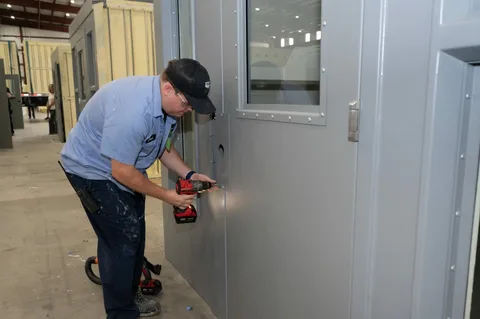A facility’s security design becomes stronger when technical expertise joins early in the process. Architects, engineers, and planners often discover that the input of a security detention equipment contractor changes the project’s entire rhythm—affecting materials, layout, and cost control. The right collaboration ensures safety measures aren’t an afterthought but an integrated part of the facility’s foundation.
When Developing Accurate Budgets and Life-cycle Cost Analysis
Budget forecasting in correctional projects requires more than estimating material and labor. Detention equipment contractors bring insight into how long detention center doors, locks, and modular components last under continuous use. Their familiarity with industry-tested products allows designers to weigh not only initial expenses but also long-term maintenance and replacement cycles.
Incorporating this guidance during early budgeting creates a more stable financial plan. Without expert input, underestimated costs often surface later—especially with specialized hardware and security-grade steel assemblies. Contractors with years of experience in detention and justice facility construction help create realistic life-cycle models that prevent last-minute funding shortfalls.
During Early Project Phases to Analyze Product Selection and Location
Choosing security-grade materials too late can derail a timeline. Early collaboration with a security detention equipment contractor allows design teams to evaluate product types, placement, and functionality before drawings are finalized. The team can assess how each element—from cell fronts to control room panels—fits operational and security needs.
This early review ensures equipment selection aligns with facility purpose. For example, the door systems in a minimum-security modular jail differ greatly from those required in a maximum-security housing unit. By considering these distinctions upfront, the team prevents procurement delays and avoids costly redesigns after approval.
To Create Specific Security Specifications and Installation Details Correctly
Security specifications require exacting detail, not broad guidelines. Detention equipment contractors contribute by defining precise standards for weld types, hardware compatibility, and material finishes. Their knowledge of detention center doors, locking systems, and anchoring points helps prevent inconsistencies between drawings and field installations. In design-build projects, these professionals also guide the drafting of installation procedures that meet both manufacturer and institutional standards. Without such precision, installers may misinterpret requirements, resulting in safety or compliance issues. The contractor’s role ensures the specifications hold up under inspection and long-term facility use.
When Identifying Potential Design Conflicts to Stop Costly Change Orders Later
Design conflicts are expensive once construction begins. Guidance from a security detention equipment contractor can identify structural, electrical, or access issues before they surface on-site. Early plan reviews help locate conflicts such as misaligned wall chases, conduit interference, or insufficient space for locking hardware. Catching these conflicts during design coordination avoids rework that can stretch budgets and schedules. Contractors experienced with detention projects have a practiced eye for how hardware, steel frames, and conduits interact. Their involvement during design review helps the project stay predictable and compliant through every phase.
If Planning the Integration of Specialized Security Electronics with Hardware
Electronic systems—such as access controls, intercoms, and surveillance—must synchronize precisely with mechanical locking systems. This integration is one of the most sensitive areas in correctional facility design. A security detention equipment contractor helps determine how electronic components align with hinges, frames, and control panels for seamless performance.
This coordination prevents wiring conflicts and ensures each electronic element operates as intended. For complex facilities with multiple control zones, collaboration between electronic integrators and detention equipment experts keeps the system unified. A missed alignment here can cause critical vulnerabilities, particularly where automated and manual systems meet.
To Ensure All Aspects of the Design Meet Relevant National Safety Standards
Correctional environments must comply with national and state safety codes that go beyond general construction standards. These include guidelines for fire resistance, escape prevention, and impact testing. Detention equipment contractors are familiar with these codes, ensuring that materials and assemblies meet or exceed regulatory expectations.
They also track ongoing revisions to standards governing modular jails and cell construction. Having that level of expertise in the design phase keeps facilities ahead of compliance audits and safety certifications. The result is a structure that meets its security function without compromising on legal or ethical requirements.
When a Facility Needs Help with Material Procurement and Lead Time Planning
Procurement delays can halt construction faster than any design flaw. Security detention equipment contractors manage supplier networks for detention center doors, hardware, and structural components. Their awareness of production timelines from prison supply manufacturers allows design teams to sequence deliveries efficiently.
Proper scheduling helps avoid installation gaps and rushed substitutions that compromise quality. Contractors coordinate with fabricators and site managers to confirm that high-security components arrive when needed. Cornerstone, an industry leader known for its work in modular jails and detention equipment, provides the specialized planning and installation expertise required to keep complex projects on track.

